| Tweet |
|
J.L. Baird & Color Moon CamerasSeparating the facts from the Green CheeseJ.L. Baird the man and J.L. Baird the legend are very different from one another. This page considers some of the more inflated claims about the Baird legend. Here we reveal the real person by debunking claims that appear on less responsible Web pages. We cite respectable references, including primary sources. |
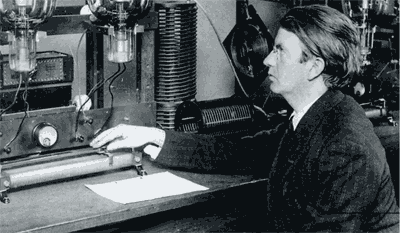
J.L. Baird in 1928 (Herbert, 1996, p. 7.) |
|
QUESTION. Did John Baird pioneer the Apollo moon color-wheel TV system? ANSWER. No. There is zero evidence that Baird understood or conceived of moon television. When moon missions began in the late 1960s, Baird had been dead for 20 years. Being dead, Baird couldn't have consulted with the Apollo, Westinghouse or RCA design teams. Note on the mooncam color wheel photo (right): The filter colors appear inverted. Mooncams used glass dichroic filters. (Lebar, 2009. See references at the end of this page.) The photo shows what look like cyan, yellow and magenta (CYM) filters. These are the rejected colors. The colors that pass through these dichroic filters are actually the complements of CYM: Red, blue and green (RBG). |
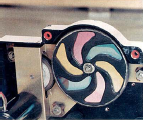
Photo of actual mooncam disc (Lebar, 1997, p. 52.) |
QUESTION. Did Baird leave behind intellectual property that others used in developing mooncams?
ANSWER. No. By 1960, field-sequential television technology was anything but novel. A person having ordinary skill in the art of television engineering understood this technology. Further, the mooncams included some of the first integrated electronics. (Svensson, 1968, p. 47; Westinghouse, 1971, p. 3-3/3-4.) Baird worked with discrete tube electronics. He died before the advent of integrated semiconductors, and would have no concept of them.
|
|
|
Unlike Baird, Peter Goldmark built field-sequential color cameras. These cameras produced 405-line, double interlaced, three-color pictures. The field rate for these pictures was 144 Hz. The frame rate was 24 fps. (Reitan, 1998)
|
Now think about the appearance of the mooncam color wheel. The Apollo camera borrows only this color wheel from earlier color TV systems. Yet the color wheel in a moon camera looks more like Peter Goldmark's wheel than Baird's wheel. Like the mooncam wheel, the Goldmark wheel includes red, blue and green (RBG) filters. Each filter covers a wedge of the wheel. Baird's preferred wheel uses a two-color gamut, with red-orange and blue-green filters. A characteristic of Goldmark's wheels is that the wedges twist by 30 degrees apiece. In this way, Goldmark wheels maximize screen coverage with the minimum wheel diameter. The Baird wheel's filter wedges are less efficient, because they don't follow the Goldmark twist. (Baird 2-color wheel: Kamm & Baird, 2002, p. 326; Goldmark 3-color wheel: Wentworth, 1955, p. 253.) |
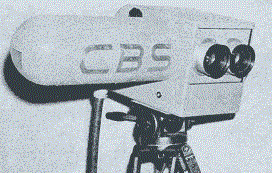
Goldmark's 3-color camera. (Eddy, 1945, p. 133) |
QUESTION. Didn't Baird's sequential color TV system precede the other sequential color systems?
ANSWER. No. Here we're talking about television with an electronically scanned camera tube. Baird was by no means the first to invent this type of two-color television.
|
Guillermo Gonzalez Camarena filed his Mexican patent for a three-color, field-sequential system on August 19, 1940. He followed this with a U.S. patent filing on August 14, 1941. The U.S. granted Camarena patent 2,296,019. (Camarena, 1941) Peter Goldmark patented his three-color system on September 7, 1940. (U.S. patent 2,304,081, etc.; some British: Abramson, 1987, pp. 262-4; p. 324 note 26.) John Baird patented his two-color system on the same day. (GB patent 545,078: Burns, 2000, pp. 364, 389 note 15.) Goldmark's demonstration came before Baird's. Goldmark demonstrated his system on August 29 and September 4, 1940. (Abramson, 1987, pp. 262-3.) Baird lagged behind and didn't demonstrate his system until January, 1941. (Abramson, 1987, pp. 267-268.) On November 20, 1940, Ernst Alexanderson demonstrated his two-color disc system with one CRT. This demonstration came several weeks before Baird's. The Alexanderson disc had orange and blue-green segments, much like the later Baird system. (Abramson, 1987, pp. 266-267; Kamm & Baird, 2002, p. 326.) |
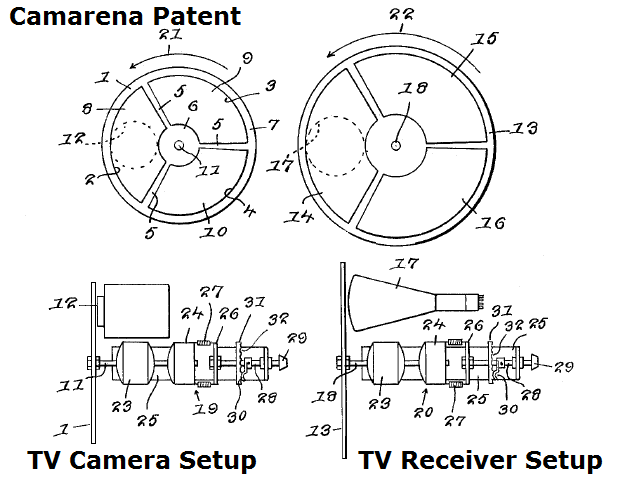 Detail from Camarena's 1941 color-wheel TV patent. (Camarena, 1941, p. 1) Click drawing for Alexanderson's
1933 patent: Orange & cyan CRTs with optics to combine the two images. (Alexanderson, 1933, p. 1)
Detail from Camarena's 1941 color-wheel TV patent. (Camarena, 1941, p. 1) Click drawing for Alexanderson's
1933 patent: Orange & cyan CRTs with optics to combine the two images. (Alexanderson, 1933, p. 1)
|
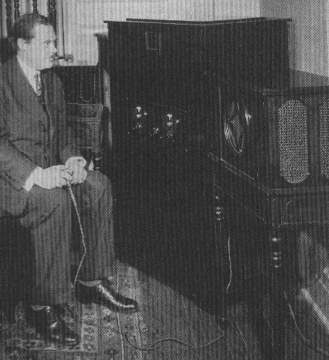 Alexanderson in 1928 with the first TV for the home
(Brittain, 1992, p. 193)
Alexanderson in 1928 with the first TV for the home
(Brittain, 1992, p. 193)
|
Alexanderson also patented a two-color (red and green) television system on May 2, 1933. (Since the patent specifies complementary colors, the "green" would have to include some blue.) Alexanderson's 1933 receiver uses two CRTs scanning alternate lines. The receiver requires no moving parts. This patent refers to a line-sequential color system. (Alexanderson, 1933) Baird noticed that his field-sequential color systems caused flicker in large areas of color. While attempting to reduce this flicker, Baird imagined a line-sequential display similar to Alexanderson's. In the Baird method, one CRT would display three side-by-side images. One image would represent each primary color. Lenses would superimpose the images onto a viewing screen. Filters would cause the images to display in red, blue and green, creating full color. Each image would have 200-line definition. In 1942, Baird patented the process in England (GB Patent 555,167). Yet apparently the interlacing scheme proved too difficult. According to historian Russell Burns (2000), no evidence exists that Baird pursued this project. (pp. 376-377) |
QUESTION. How about mechanical color TV? Wasn't Baird first with that in 1928?
|
ANSWER. No. True, Goldmark (1973) admits that Baird's 1928 mechanical color system was an inspiration. (p. 56.) Yet Baird had himself copied sequential color TV from an earlier invention. Baird assiduously read Korn and Glatzel's 1911 book Handbuch der Phototelegraphie und Telautographie. (Burns, 2000, p. 33; Korn & Glatzel, 1911.) In this book is a description of Frankenstein and Jaworski's prior field-sequential system. (Shiers, 1996, pp. 55-56, item 412.) During 1904, the two men received German patent 172,376. (Abramson, 1987, pp. 24 and 277.) Frankenstein and Jaworski's system used discs with three additive color filters. Field-sequential technology actually started in the motion picture film industry. In the first half of the twentieth century, Kinemacolor was one of many field-sequential motion picture systems. A Briton, Edward R. Turner patented his two color (red and green) movie system in 1889. After Turner's death, Charles Urban and C. Albert Smith developed Turner's work. Result: A practical two-color, field-sequential motion picture system. This system debuted in 1906 as Kinemacolor. Kinemacolor cameras expose alternate film frames to red-orange or blue-green-filtered light. The film runs through the camera at 32 frames per second (fps). This is twice the 16 fps typical of silent cameras of the day. The reason for the speed (and cost) increase: The projector must display two color frames per image. The frames project in succession. A viewer's eyes fuse the two frames into a full-color image. The Kinemacolor camera and projector each contain the same type of revolving color wheel. (Hart, Kinemacolor, 1997-1998; Ryan, 1977, pp. 26-29) |
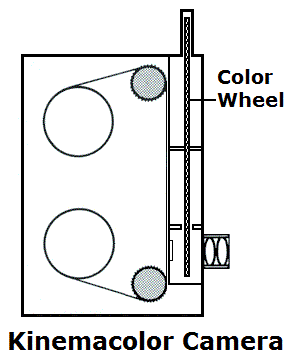
Kinemacolor camera diagram, showing film path. Click image for Kinemacolor two-color wheel. (Ryan, 1977, p. 28.) |
As with other field-sequential processes, Kinemacolor images appear to blur in areas of motion. In fact, motion causes red and green “rainbows” to appear on screen. The same rainbows or “color fringes” are apparent in color TV transmissions from the Apollo moon missions. (The color mooncams all used field-sequential TV technology.) Returning to Kinemacolor, blue wouldn't reproduce properly: Unlike the mooncams, Kinemacolor cameras and projectors have no blue filters. (Hart, Kinemacolor, 1997-1998; Ryan, 1977, pp. 26-29)
On March 20, 1928, Ray Kell at General Electric patented a two-color disc TV system. He beat Baird's first color patent by over two months. (Abramson, 1987, pp. 111 and 118.) Later, Kell ran the color TV development group at RCA. (Webb, 2005, p. 56) The bottom line: Baird didn't invent field-sequential color or color wheel television. He copied it.
Still insist that Baird invented color wheels and field-sequential color? See this related page with 1902 movies by the Turner field-sequential color system: Restored Turner movie in color
This Kinemacolor page provides several clips of pre-Baird field-sequential color films.
QUESTION. Who really invented field-sequential color TV?
ANSWER. The first field-sequential color system for TV came out of Russia in 1899. The Russian inventor was A.A. Polumordvinov. Russian patent records unmistakably prove the Polumordvinov claim. (Abramson, 1987, p. 22; Shiers, 1996, p. 36)
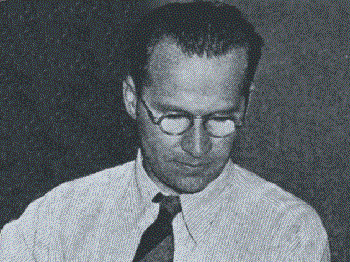
Portrait of Peter Goldmark (Eddy, 1945, p. 131.) |
QUESTION. Did Peter Goldmark pioneer the Apollo moon color-wheel TV system? ANSWER. No. Only the Goldmark disc (Goldmark, 1940) recurs in the Apollo system. The first color mooncams used Secondary Electron Conduction tubes (SEC). The SEC is a hardened version of the vidicon. (Westinghouse, 1971, p. 3-7) Apollos 13 and 14 used SEC tubes with improved heat shielding. (Westinghouse, 1970, pp. 7-10) Apollos 15 through 17 used Silicon Intensifier Target (SIT) tubes. The SIT is less sensitive to the sun's rays than were previous tubes. (Russell, 2013, p. 2) None of the earlier inventors used or invented the vidicon, SEC or SIT. The camera's electronics, which included some of the first integrated circuits, were largely new. The downlink station converted lunar video into NTSC by a different process than Goldmark used. |
QUESTION. What if a prominent Web site claims that some Baird invention was part of the mooncams?
ANSWER. Prominence is no guarantee of accuracy. For example: Below is a quotation from a Baird-related Web site. This quotatation has no basis in fact.
“Baird's spinning colour wheel was part of the design of the special NASA colour camera which televised the moon landing in 1969 and it is also a feature of many digital light projection (DLP) televisions. Modern 3D television, using polarized glasses, can be traced back to the work of Baird over 60 years ago.” As we've proven, no connection exists between Baird and the Apollo color mooncams. Further, Baird didn't invent field-sequential TV or color wheels. Notice that no supportive footnote follows either claim above. An earlier footnote connects to a Westinghouse press release about color mooncams. Yet this press release draws no connection between mooncam color wheels and Baird. (Westinghouse, 1969) In an email to me below, the webmaster disavows his NASA color wheel assertion. (To protect privacy, I've altered the writer's name.) “I made no such claims. The only specific points that I brought up were the COLOR WHEEL and field-sequential technology which were developed into a working system more or less independently by [J.L. Baird] and Peter Goldmark of CBS.” (“Colin Jaeckel,” personal communication, September 21, 2009) Mr. “Jaeckel's” statement about Baird and polarized glasses is also incorrect. For instance, Edwin Land demonstrated 3D moving images with polarized glasses long before Baird did. In 1934, Land's polarized lenses for a 3D movie projector and eyeglasses received U.S. patent 2,099,694. (Land, 1934) Land demonstrated his glasses at a public 3D movie presentation in 1936. (Polarized 3D System, 2014) The Land patent followed an earlier patent on the polarizer and polarizer fabrication. (Land and Friedman, 1929) Baird's 3D polarized glasses demonstration didn't occur until 1941. (Burns, 2000, pp. 367-369) |
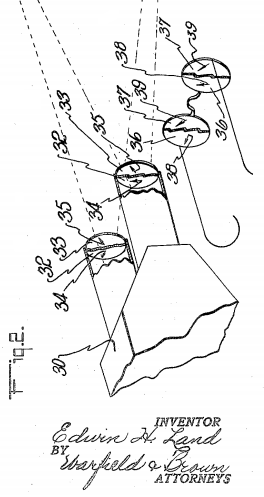
Edwin Land's polarized 3D projector and glasses (Land, 1934, p. 1) |
The 1884 Nipkow television patent includes two Nicol prisms (Abramson, 1987, pp. 13-15). A Nicol prism is another type of light polarizer. The Nipkow patent, from which Baird copied several mechanisms, dates from four years before Baird's birth.
|
QUESTION. When Neil Armstrong stepped onto the moon, didn't the lunar camera use Baird’s color system? ANSWER. No, for several reasons...
|
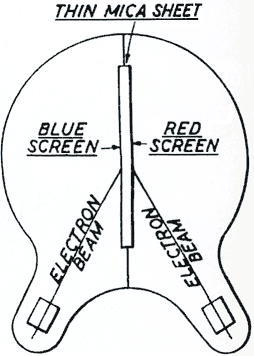
Conceptual drawing: Baird's 1944, two-color Telechrome tube (Herbert, 1996, p. 26) |
QUESTION. Wasn't Baird's field-sequential color camera the best and most reliable camera available?
ANSWER. No. Wrong in many ways. Here are a few...
|
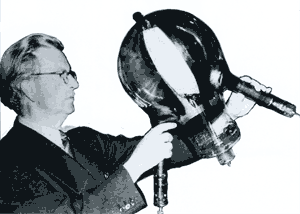
Actual 2-color Telechrome is less compact than the drawing (previous FAQ) suggests. This awkward prototype has 3 long necks. (Herbert, 1996, p. 26) |
- None of Baird's experimental color systems conform to world TV standards. Use of Baird's standards probably would have required expensive scan converters. Example: Telechrome produces 600 lines through triple interlacing. One color frame requires six scans. This is a two-color, field-sequential display system. (Herbert, pp. 22-26). In contrast, the analog world TV standards NTSC, PAL and SECAM use simultaneous three-color displays. The interlace ratio for NTSC, PAL and SECAM is two to one. One color frame requires only two scans. The resultant frame has 525 lines for NTSC, or 625 lines for PAL and SECAM.
- Baird's Telechrome tube is too ungainly to fit in the LEM cabin and too fragile to make the journey.
QUESTION. Since the mooncam didn't use Baird's electronic technology, did it use his mechanical technology?
ANSWER. No, the mooncam didn't use Baird's mechanical technology.
Long before the NASA space program, Baird's mechanical system was obsolete. Westinghouse (1970) mooncams produced vastly superior resolution. The Westinghouse cameras were smaller, lighter and less clumsy.
Just as with his electronic color experiments, Baird used a flying-spot scanner for his 1928 mechanical color demonstration. (Moseley and Barton-Chappel, 1940, pp. 11 & 147) A scanner would be impractical in the lunar environment. To provide a usable scan, the scanning projector would have to overcome ambient light from the sun. (Either that, or shoot only subjects in the dark. This strategy would be useless for landscapes, where the subject would be outside the range of a scanner's light.) A color camera and not a scanner was the appropriate technology for the moon landing.
The basic difference between a scanner and a camera is this...
- A scanner projects an internal light source on the subject. There are no light detectors inside a TV scanner. Instead, these detectors are outside the scanner. If non-scanned light falls on these detectors, the light competes with the scanned light. That is, ambient light is a source of noise. Such light upsets the picture's black level.
- Unlike a scanner, a camera has no internal light source. Instead, a light-tight chamber inside the camera contains light detectors. Only a camera leak can allow ambient light to damage the picture.
Albert Abramson (1987) mentions an experimental broadcast where a flying spot scanner actually functioned outdoors. In 1928, Ray Kell scanned an outdoor speech by New York Governor Al Smith. For awhile, the scanner's 1,000-watt lamp could adequately light the scene. During Smith's rehearsal, the TV pictures were satisfactory. Unfortunately the scanner was unable to reproduce the actual event. Just before it started, newsreel cameramen switched on their arc-lamps. The light from these lamps swamped out the scanning lamp and ended the TV test. (p. 124)
NASA engineers could expect similar problems with a Baird color TV scanner. Sunlight falling on the scanner detector bank would wipe out the image. Such imaging problems are another reason why NASA chose cameras and not mechanical scanners for the moon landing.
One can imagine a use for a miniature scanner, say for reproducing images of rock samples. If the sample would fit inside the scanner, ambient light wouldn't be a problem. Unfortunately the costs of designing such a device and shipping it to the moon were prohibitive. Maybe a future mission will send such a scanner into space.
QUESTION. Is there a space application for two-color, field-sequential technology, such as Camarena, Baird and Alexanderson engineered?
ANSWER. Yes. Of course, even in Baird's day, two-color field-sequential technology wasn't new. Ryan (1977) discusses several two-color, additive processes that were useful in the early film industry. (pp. 26-45) Two-color was cheaper, simpler and easier to use than three-color technology. The same advantages might apply to space video. Another advantage also applies: Transmitting only two colors might require less bandwidth than transmitting three colors. Or sending only two colors might require less time than sending three. (Transmission time or speed could also depend on multiplexing schemes.)
Disadvantage. Hart (Cinecolor, 1998) discusses the disadvantage of two-color processes: They only render some objects in natural color. This is the reason that most two-color processes use the primaries red-orange and cyan or teal (blue-green). In fact, these are the colors that Camarena, Baird and Alexanderson wisely chose. Why? Because these colors render flesh tones nearly perfectly. Viewers' eyes seem to be most sensitive to colors in this range.
Talking heads. On a space mission, two-color TV would probably be ideal for cabin shots: In such shots, the main subject would be astronauts' heads. After a landing, accurate scenery pictures would be important. No worry: On the moon, most of the terrain is gray. Again, two-color pictures would prove at least adequate. On Mars, there is much reddish dust. Red and cyan might also do the trick. (One important exception: National pride. Blue stripes in the American flag or blue triangles in the Union Jack would appear gray!)
Now let's consider a mission to a blue or green planet, say Uranus or Neptune. Here, our red and cyan technology would likely be inadequate. Either that, or engineers would have to change the two colors. What colors would you choose? (Hint: The two colors must be 180 degrees apart on the color wheel.) How about yellow and blue? Maybe green and magenta? Those colors might be just the ticket for panoramas. Yet the astronauts' faces would seem peculiar. Flight doctors on earth might attempt to treat these ruddy or jaundiced souls: “Oh, no! Could it be space sickness?”
Removing color. We've talked about two-color technology to show particular colors. Two color might also be useful in eliminating certain colors. Imagine a voyage to a planet where a cloud layer casts a strong color on the ground. Despite this color, one of our goals is to view minerals on the surface. We engineer our camera to be blind to the cloud color. Then the ground minerals appear to our camera without contamination from the clouds.
Future video cameras for space will be more complex than the Apollo mooncams. Perhaps future mooncams will detect not two or three, but four or six colors. Maybe astronauts will be able to pick a palette and choose which colors to gather. Solid-state imagers can be more resilient than the glass camera tubes of the 1969 moon landing. Space missions will probably use digital transmissions instead of FM, as in Apollo missions.
Extreme miniaturization and computerization will permit amazing new features. For example, one or more cameras might become part of a space helmet visor. High dynamic range methods that digitally combine bracketed exposures are quite likely. Fully intelligent cameras might be the next step. Autonomous cameras, that is, robot videographers, might not be too far off. Technology that couples to the visual cortex is quite possible. Someday soon, images might spring directly from the brain. Television reception might mean impressing video directly onto the neural net. Then only the imagination can limit the number of colors.
Bibliography
Abramson, Albert. The History of Television, 1880 to 1941. Jefferson, North Carolina: McFarland & Company, 1987.
Alexanderson, Ernst F. W. Colored Television Apparatus. U.S. patent 1,988,931, filed May 2, 1933 and issued January 22, 1935.
"All Talking! All Singing! All Dancing! A Celebration of the early talkies and their times," access on April 21, 2014. http://talkieking.blogspot.com/2010/03/color-in-movies-part-1-kinemacolor.html
Brittain, James E. Alexanderson: Pioneer in American Electrical Engineering. Baltimore, 1992: Johns Hopkins University Press.
Burns, Russell. John Logie Baird, Television Pioneer. London: The Institution of Electrical Engineers, 2000. (This book is part of the IEE History of Technology series.)
Camarena, Guillermo Gonzalez. Chromoscopic Adapter for Television Equipment. U.S. patent 2,296,019, filed August 14, 1941, and issued September 15, 1942.
Dinsdale, Alfred. First Principles of Television. New York: Arno Press, 1971. (This is a reprint of the 1932 edition by publisher Wiley.)
Eddy, William C. Television: The Eyes of Tomorrow. New York: Prentice-Hall, Inc., 1945.
Hart, Martin. "Cinecolor," 1998, access on April 16, 2014. http://www.widescreenmuseum.com/oldcolor/cinecolor2.htm
Goldmark, Peter C. "Polarizing Optical System," U.S. patent 2,304,081, filed September 7, 1940, and issued December 8, 1942.
Goldmark, Peter C. Maverick Inventor: My Turbulent Years at CBS. New York: Saturday Review Press, 1973.
Hart, Martin. "Kinemacolor: The first Successful Color System," 1997-1998, access on March 21, 2014. http://www.widescreenmuseum.com/oldcolor/kinemaco.htm
Herbert, Ray. Seeing by Wireless: The Story of Baird Television. Sanderson, Surrey, England: Herbert, 1996.
Kamm, Antony and Malcolm Baird. John Logie Baird: A Life. Edinburgh: National Museums of Scotland, 2002, 326.
Korn, Arthur and Bruno Glatzel. 1911. Handbuch der Phototelegraphie und Telautographie. Leipzig: Otto Nemnich Verlag, 1911.
Land, Edwin H. "Polarizing Optical System," U.S. patent 2,099,694, filed March 6, 1934, and issued November 23, 1937.
Land, Edwin H. and Joseph S. Friedman. "Polarizing Refracting Bodies," U.S. patent 1,918,848, filed April 26, 1929, and issued July 18, 1933.
"La premičre vidéo en couleur au Monde," access on April 21, 2014. http://www.tayo.fr/la-premiere-video-en-couleur-au-monde-news.php/ This page contains restored 1902 movies by the Turner field-sequential color system. Experts at the National Media Museum performed the restoration. They explain the restoration process.
Lebar, Stanley. "The Color War Goes to the Moon," Invention & Technology, Summer, 1997, p.52.
Lebar, Stanley. Private correspondence about Westinghouse and its role in developing color TV cameras for the Apollo moon program, 2009.
Lloyd, C.G. "Chromacoder Colorcasting," IRE Transactions in Broadcast Transmission Systems, March, 1955, 49-54.
Moseley, Sydney A. and H. J. Barton Chapple. Television Today & Tomorrow. London: Sir Isaac Pitman & Sons, Ltd., 1933.
"Polarized 3D System," Wikipedia, Access on March 24, 2014.
RCA Government and Commercial Systems, Astro-Electronics Division. Ground-Controlled Television Assembly: Operation and Checkout Manual. Rev. ed. Princeton, New Jersey, 1972.
Reitan, Edwin Howard, Jr. "CBS Field Sequential Color System," 1998, access on April 28, 2014. http://www.novia.net/~ereitan/Color_Sys_CBS.html A comprehensive resource on the history of color TV development.
Russell, Sam. "Shooting the Apollo Moonwalks: A Recollection of How It Was Done," Access on February 2, 2013. http://www.hq.nasa.gov/alsj/Shooting-Moonwalks.pdf Also see: http://www.russelland.com/speaking_of_video/moonwalk.html
Ryan, Roderick T. A History of Motion Picture Color Technology. London: Focal Press Limited, 1977.
Shiers, George. Early Television: A Bibliographic Guide to 1940 (Garland Reference Library of Social Science) New York: Routledge, 1996.
Svensson, E.L. "The Lunar Television Camera," Westinghouse Engineer, March 1968.
Webb, Richard C. Tele-Visionaries: The People Behind the Invention of Television. Hoboken, NJ: John Wiley & Sons, 2005.
Wentworth, John. Color Television Engineering. New York: McGraw-Hill, 1955.
Westinghouse Defense and Space Center, Aerospace and Electronic Systems Division. Apollo Color Television Subsystem Operation and Training Manual. Baltimore: Westinghouse, 1971.
Westinghouse Electric Corporation. "Westinghouse Builds Color TV Camera and 'Mini' Monitor for Apollo 10," media release, Pittsburgh, PA, May 16, 1969.
Westinghouse Electric Corporation. "Westinghouse TV Cameras Bring Apollo Video from Liftoff to Lunar Landscape," media release, Pittsburgh, PA, 1970.
Wood, Bill. "Apollo Television." NASA, 2005.
Access on April 8, 2014. http://www.hq.nasa.gov/alsj/ApolloTV-Acrobat5.pdf Wood was the lead engineer at Goldstone USB.
Go to Page:
1
2
3
4
5
Back


